Bioinformatics
Type of resources
Available actions
Topics
Keywords
Contact for the resource
Provided by
Years
Formats
Representation types
-

ddRAD genotyping was used to evaluate population connectivity and putative loci under selection in honeycomb worm from 13 sites spanning its distribution in the Atlantic and Mediterranean coasts.
-

DNA sequencing of Crassostrea gigas Pacific oyster spat infected in the wild with OsHV-1 virus in 4 French oyster basins (Marennes Oleron Bay, Arcachon bay, Rade de Brest and Thau lagoon).
-

scRNA-seq reads from a Pacific oyster (Crassostrea gigas) hemocyte preparation. Hemocytes were isolated from a unique immunologically naive animal (Ifremer Standardized Animal, 18 months) and single-cell drop-seq technology was applied to 3,000 individual hemocytes.
-

Successive infections with Vibrio harveyi were conducted in two populations of the European abalone in order to examine which genes may be involved in improved survival to the disease in the St. Malo population.
-

The present data set concerne metabarcoding raw reads produced using 4 different PCR targeting polymerase or capside coding region of the genoyupe I and II of norovirus. Test samples of norovirus with serial dilutions in pure water and after a bio-accumulation in oysters. Sequencing was made after VirCapSeq-VERT approach.
-

WGS for Iatlantic projet ( ) for assessing past and present connectivity
-

Whole genome pooled sequencing of individuals from 4 populations and 3 different color phenotype in order to uncover the genetic variants linked to color expression in the pearl oyster P. margaritifera.
-

The project was designed to explore biological rhythms in the hydrothermal vent mussel Bathymodiolus azoricus. The experiment provides the first high-resolution temporal transcriptomes of an hydrothermal species, both in situ and in the laboratory.
-

2bRAD genotyping will be used to estimate genetic diversity and connectivity among populations of Sabellaria alveolata. We will relate population genetic parameters with reef state characteristics.
-

Here, our study aimed to first assess the influence of plastic on the bacterial community belonging to water, plastic and the microbiome of the giant clam and on the organism's physiology of this putative sentinel species. Our second objective was to identify bacteria whose abundance varies significantly with plastic concentration. Overall, this study will fill the gap towards a better understanding of the impact of plastic pollution on bacterial community assemblages in both inert and living environments.
 Catalogue PIGMA
Catalogue PIGMA